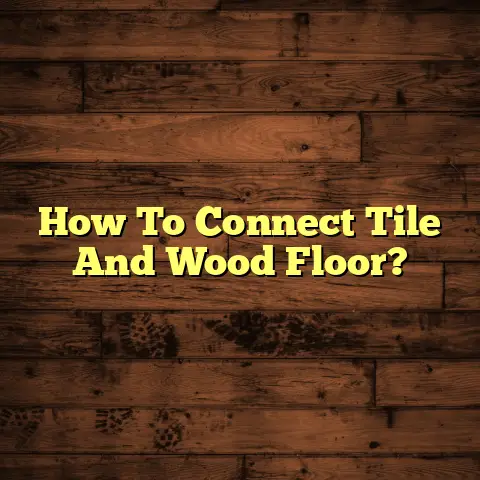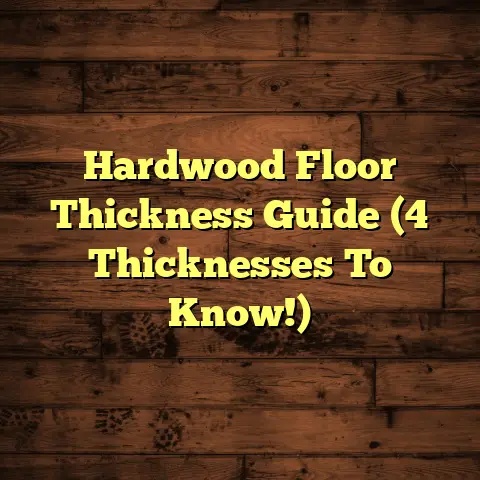Installing Hardwood On Stairs: How-To? (4 Common Fails!)
I’m excited to talk about something near and dear to my heart: hardwood on stairs.
If you’re anything like me, you’re always looking for ways to elevate your home’s style and value.
And let me tell you, installing hardwood on your stairs is a game-changer.
It’s a trend I’m seeing everywhere these days, and for good reason.
Hardwood flooring has exploded in popularity, and it’s not just for living rooms anymore.
Think about it: stairs are a focal point in your home. They connect different levels and can make a huge statement.
Choosing the right flooring for them is crucial. Hardwood brings a timeless elegance and durability that’s hard to beat.
Plus, it instantly boosts your home’s aesthetic appeal. Ready to dive in? Let’s get started!
The Appeal of Hardwood on Stairs
So, why is everyone going crazy for hardwood stairs? Well, let me break it down for you.
First off, you’ve got options, my friend! We’re talking oak, maple, cherry, and even exotic woods like Brazilian walnut.
Each type brings its own unique character and grain pattern.
Oak is classic and durable, maple offers a clean, modern look, and cherry adds a touch of warmth and luxury.
And those exotic woods? They’re for when you really want to make a statement!
One of the things I love most about hardwood is its versatility.
It can seamlessly blend with any interior style, whether you’re rocking a traditional vibe or a sleek, contemporary design.
I’ve seen it all, and trust me, hardwood always looks amazing.
Now, let’s talk numbers.
Did you know that upgrading to hardwood floors can significantly increase your home’s value?
According to a recent study by the National Association of Realtors, homes with hardwood floors can sell for as much as 2.5% more than those without.
And when it comes to stairs, that impact can be even greater.
A beautifully crafted hardwood staircase can be a major selling point, attracting buyers and boosting your property’s overall appeal.
Preparing for Installation
Alright, so you’re convinced that hardwood stairs are the way to go. Great!
But before you start ripping up your old carpet, let’s talk about preparation.
This is where the magic happens, and trust me, you don’t want to skip any steps.
First, gather your tools and materials. Here’s a checklist to get you started:
- Hardwood planks or treads
- Measuring tape
- Saw (circular saw or miter saw)
- Construction adhesive
- Nail gun or staple gun
- Hammer
- Level
- Square
- Sandpaper
- Stain and sealant (optional)
- Safety glasses
- Dust mask
Measuring accurately is crucial. I can’t stress this enough.
Take your time and double-check your measurements before making any cuts.
Improper measurements can lead to gaps, uneven placement, and a whole lot of headaches down the road.
Next up: selecting the right type of hardwood. Consider factors like traffic, wear and tear, and your local climate.
If you have a busy household with kids and pets, you’ll want to choose a durable hardwood like oak or maple.
For areas with high humidity, engineered hardwood might be a better option, as it’s less prone to warping.
And speaking of warping, let’s talk about acclimation. This is a step that many DIYers overlook, but it’s essential for a successful installation.
Acclimating the hardwood to your home’s environment before installation helps prevent warping, shrinking, or expansion after the fact.
Simply bring the hardwood into your home and let it sit for at least 3-5 days before you start working with it.
This allows the wood to adjust to the temperature and humidity levels, ensuring a more stable and long-lasting installation.
Step-by-Step Installation Guide
Okay, now for the fun part: installing the hardwood! Follow these steps carefully, and you’ll be rocking those gorgeous hardwood stairs in no time.
-
Remove the Old Flooring:
- Start by removing any existing carpet, tile, or other flooring from the stairs.
- Use a pry bar or scraper to remove any old adhesive or staples.
- Make sure the stair treads and risers are clean, smooth, and free of debris.
- Start by removing any existing carpet, tile, or other flooring from the stairs.
-
Prepare the Stair Treads and Risers:
- Inspect the stair treads and risers for any damage or imperfections.
- Repair any cracks or holes with wood filler.
- Sand the surfaces smooth to create a level base for the hardwood.
- Consider adding underlayment to reduce noise and provide extra cushioning.
- Inspect the stair treads and risers for any damage or imperfections.
-
Cut and Fit the Hardwood:
- Measure each stair tread and riser individually, as they may not all be the same size.
- Use a saw to cut the hardwood planks or treads to the correct dimensions.
- Dry-fit each piece to ensure a snug fit before applying adhesive or fasteners.
- Measure each stair tread and riser individually, as they may not all be the same size.
-
Secure the Hardwood:
- Apply construction adhesive to the back of each hardwood piece.
- Position the hardwood on the stair tread or riser and press firmly into place.
- Use a nail gun or staple gun to secure the hardwood further.
- Make sure the fasteners are countersunk to prevent them from interfering with the finish.
- Apply construction adhesive to the back of each hardwood piece.
-
Finishing Touches:
- Once the hardwood is installed, sand any rough edges or imperfections.
- Apply stain to match your desired color scheme.
- Seal the hardwood with a protective finish to prevent scratches and wear.
- Allow the finish to dry completely before using the stairs.
- Once the hardwood is installed, sand any rough edges or imperfections.
4 Common Fails in Hardwood Stair Installation
Alright, let’s get real. Installing hardwood on stairs isn’t always a walk in the park.
I’ve seen my fair share of DIY disasters, and I want to help you avoid the most common pitfalls.
Here are four fails that can turn your dream staircase into a nightmare:
Fail #1: Inaccurate Measurements
This is the number one mistake I see, and it’s a biggie. Improper measurements can lead to gaps, uneven placement, and a staircase that looks… well, let’s just say less than professional.
Imagine spending hours installing your hardwood, only to find that the last piece is too short or too long. Frustrating, right?
Accurate measurements are key to a flawless finish.
Fail #2: Skipping the Preparation Steps
I know, I know, prepping isn’t the most exciting part of the project.
But trust me, it’s essential. Neglecting to prepare the stairs adequately can lead to complications during installation and a subpar finish.
Think of it this way: you wouldn’t build a house on a shaky foundation, would you?
The same goes for your hardwood stairs.
Make sure to clean, sand, and level the stair treads and risers before you start installing the hardwood.
Fail #3: Not Acclimating the Wood
I touched on this earlier, but it’s so important that I’m going to say it again: acclimate your hardwood!
Failing to do so can result in warping, shrinking, or expansion after installation.
And trust me, you don’t want to deal with that mess.
Acclimating the wood allows it to adjust to your home’s temperature and humidity levels, ensuring a more stable and long-lasting installation.
Fail #4: Poor Adhesive or Fastening Choices
Using the wrong type of adhesive or fastening technique can result in loose boards, squeaky stairs, and eventual failure of the installation.
Not all adhesives are created equal.
Make sure to choose a construction adhesive that’s specifically designed for hardwood flooring.
And when it comes to fasteners, consider using a nail gun or staple gun for added security.
Conclusion
So, there you have it: everything you need to know about installing hardwood on stairs.
It’s a challenging project, but with careful planning, attention to detail, and a little bit of elbow grease, you can create a stunning staircase that will enhance the beauty and value of your home.
Just remember to avoid those common pitfalls, and take your time during the installation process.
Trust me, the end result is well worth the effort! Now, go forth and conquer those stairs! You got this!





